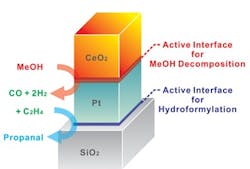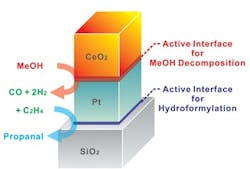New Concept Targets Sequential Reactions
Researchers at the U.S. Department of Energy's Lawrence Berkeley National Laboratory, Berkeley, California, have come up with a new approach for designing high-performance multifunctional catalysts. It centers on creating nanocrystals with distinct metal/metal-oxide layers that can catalyze sequential reactions.
[sidebar id="2"]The researchers have demonstrated the use of such a bilayer nanocatalyst to produce propanal from methanol and ethylene. The tandem catalyst provided better selectivity and turnover frequency than conventional ones for making propanal. These likely will be general benefits of the approach, notes Piedong Yang, a chemist at Berkeley Lab's Materials Sciences Division and the University of California Berkeley's Chemistry Department and Department of Materials Science and Engineering, and lead researcher on the project.
"The demonstration of rationally designed and assembled nanocrystal bilayers with multiple built-in metal-metal oxide interfaces for tandem catalysis represents a powerful new approach towards designing high-performance, multifunctional nanostructured catalysts for multiple-step chemical reactions," he says.
Yang adds this new process is especially valuable for applications in which multiple sequential reactions are needed to produce chemicals in a highly active and selective manner.
"The basic concept here is that we will be able to design different interfaces for different chemical reactions, and put these interfaces together such that we can program the multiple-step chemical reactions step-by-step, and that we can eventually program and select the final chemical reaction products."
For propanal production, Yang and his team deposited nanocube monolayers of platinum and cerium oxide on a silica (silicon dioxide) substrate using the Langmuir-Blodgett assembly technique. The nanocube layers were then stacked one on top another to form two distinct metal/metal-oxide interfaces.
Cerium oxide-platinum on one layer catalyzed the decomposition of methanol to carbon monoxide and hydrogen, which then were used in ethylene hydroformylation catalyzed by platinum-silica to form propanal (Figure 1).
"The cubic shape of the nanocrystal layers is ideal for assembling metal/metal-oxide interfaces with large contact areas," Yang says. "Integrating binary nanocrystals to form highly ordered superlattices is a new and highly effective way to form multiple interfaces with new functionalities."
More details on the research appear in a recent paper in Nature Chemistry.
The team's next step is studying the metal-oxide interface in the tandem nanocrystal system using spectroscopic techniques. Yang also is looking to extend the tandem concept to "other more important reactions."
Currently, the development is still in the early stages and there are no plans yet to run pilot-plant-scale tests of the tandem catalysts.
"These are ongoing reactions. We're … at the beginning of this whole new concept, [and] there are lots of things to do next," says Yang.
"The key challenge is designing the suitable interfaces for a particular multiple step chemical reaction. These metal-oxide interfaces have to be carefully selected so that we can achieve the desired activity and selectivity," he adds.

